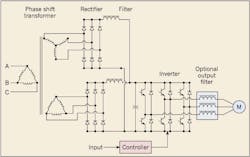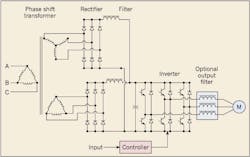Variable speed drives (VFDs) can (and do) save energy in multiple ways. Of course, the degree of savings depends upon the application, the drive features, and how you have the drive set up. Generally, you can look forward to saving money in these ways:
• Built-in power factor correction. Many facilities have power factor (PF) correction capacitors at the service, and they put them there only to escape a PF penalty from the electric utility. Back at the load, they are wasting power because of low PF. A PF-corrected drive eliminates all or nearly all of this waste.
• Built-in harmonics correction. Harmonics waste energy and cause a motor to run hotter (sometimes a lot hotter). A hotter motor is less efficient. Correct for excess harmonics (particularly the third and fifth for motors) and your motors last longer and use less energy.
• Soft Starting. Buying a VFD just to get soft starting is not very smart, because soft starters cost much less than a VFD. But this feature is a standard VFD feature, and when properly set up will not only extend the life of the motor but also reduce its energy usage. For particularly large motors, the deleterious effects on the whole distribution system of across-the-line starting can be eliminated.
• Speed control on the input (rather than on the output with a gearbox). This is really application-specific. You may still want the gearbox for torque multiplication, something a VFD cannot give you. You save energy if you simply reduce the motor speed, rather than dissipating the work already done by the motor. For example, a hydraulic system may use a pressure relief or bypass valve that shunts some flow back to the reservoir to keep system pressure at spec while the motor runs full-tilt. Running the motor at exactly the speed needed to provide the required pressure eliminates this waste.
• Continuous drive instead of ON/OFF. This is also application-specific. For example, a motor is oversized to meet some idea of a maximum load that, in reality, is never there (this is pretty common). The motor cycles on and off. The VFD can effectively “right size” the motor to the load it actually is driving by throttling it back.
About the Author

Mark Lamendola
Mark is an expert in maintenance management, having racked up an impressive track record during his time working in the field. He also has extensive knowledge of, and practical expertise with, the National Electrical Code (NEC). Through his consulting business, he provides articles and training materials on electrical topics, specializing in making difficult subjects easy to understand and focusing on the practical aspects of electrical work.
Prior to starting his own business, Mark served as the Technical Editor on EC&M for six years, worked three years in nuclear maintenance, six years as a contract project engineer/project manager, three years as a systems engineer, and three years in plant maintenance management.
Mark earned an AAS degree from Rock Valley College, a BSEET from Columbia Pacific University, and an MBA from Lake Erie College. He’s also completed several related certifications over the years and even was formerly licensed as a Master Electrician. He is a Senior Member of the IEEE and past Chairman of the Kansas City Chapters of both the IEEE and the IEEE Computer Society. Mark also served as the program director for, a board member of, and webmaster of, the Midwest Chapter of the 7x24 Exchange. He has also held memberships with the following organizations: NETA, NFPA, International Association of Webmasters, and Institute of Certified Professional Managers.

